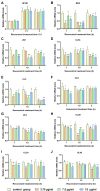Resveratrol Inhibits Pseudorabies Virus Replication by Targeting IE180 Protein
- PMID: 35722304
- PMCID: PMC9203040
- DOI: 10.3389/fmicb.2022.891978
Resveratrol Inhibits Pseudorabies Virus Replication by Targeting IE180 Protein
Abstract
Resveratrol is a natural polyphenolic product in red wine and peanuts and has many pharmacological activities in humans. Our previous studies showed that resveratrol has good antiviral activity against the pseudorabies virus (PRV). However, little is known about the antiviral mechanism of resveratrol against PRV. In this study, we found that resveratrol inhibited the nuclear localization of IE180 protein, which is an important step for activating early/late genes transcription. Interestingly, the results show that resveratrol inhibited the activity of IE180 protein by dual-luciferase assay. Furthermore, molecular docking analysis shows that resveratrol could bind to the Thr601, Ser603, and Pro606 of IE180 protein. Point mutation assay confirmed that resveratrol lost its inhibition activity against the mutant IE180 protein. The results demonstrate that resveratrol exerts its antiviral activity against PRV by targeting the Thr601/Ser603/Pro606 sites of IE180 protein and inhibiting the transcriptional activation activity of IE180 protein. This study provides a novel insight into the antiviral mechanism of resveratrol against herpes viruses.
Keywords: IE180 protein; antiviral; molecular docking; pseudorabies virus; resveratrol.
Copyright © 2022 Chen, Song, Li, Chen, Jia, Zou, Wan, Zhao, Tang, Lv, Zhao and Yin.
Conflict of interest statement
The authors declare that the research was conducted in the absence of any commercial or financial relationships that could be construed as a potential conflict of interest.
Figures









Similar articles
-
Characterization of a replication-incompetent pseudorabies virus mutant lacking the sole immediate early gene IE180.mBio. 2014 Nov 11;5(6):e01850. doi: 10.1128/mBio.01850-14. mBio. 2014. PMID: 25389174 Free PMC article.
-
Pseudorabies Virus IE180 Inhibits Virus Replication by Activating the Type I Interferon Pathway.Microorganisms. 2025 Jun 16;13(6):1397. doi: 10.3390/microorganisms13061397. Microorganisms. 2025. PMID: 40572285 Free PMC article.
-
Suppression of pseudorabies virus replication by a mutant form of immediate-early protein IE180 repressing the viral gene transcription.Vet Microbiol. 1998 Feb 28;60(2-4):107-17. doi: 10.1016/s0378-1135(97)00153-3. Vet Microbiol. 1998. PMID: 9646443
-
Expression of the immediate early IE180 protein under the control of the hTERT and CEA tumor-specific promoters in recombinant pseudorabies viruses: Effects of IE180 protein on promoter activity and apoptosis induction.Virology. 2016 Jan 15;488:9-19. doi: 10.1016/j.virol.2015.10.028. Epub 2015 Nov 17. Virology. 2016. PMID: 26590793
-
A Tug of War: Pseudorabies Virus and Host Antiviral Innate Immunity.Viruses. 2022 Mar 6;14(3):547. doi: 10.3390/v14030547. Viruses. 2022. PMID: 35336954 Free PMC article. Review.
Cited by
-
The prevention strategies of swine viruses related to xenotransplantation.Virol J. 2023 Jun 13;20(1):121. doi: 10.1186/s12985-023-02090-3. Virol J. 2023. PMID: 37312151 Free PMC article. Review.
-
Dihydromyricetin Inhibits Pseudorabies Virus Multiplication In Vitro by Regulating NF-κB Signaling Pathway and Apoptosis.Vet Sci. 2023 Feb 2;10(2):111. doi: 10.3390/vetsci10020111. Vet Sci. 2023. PMID: 36851415 Free PMC article.
-
Identification of Na+/K+-ATPase Inhibitor Bufalin as a Novel Pseudorabies Virus Infection Inhibitor In Vitro and In Vivo.Int J Mol Sci. 2023 Sep 23;24(19):14479. doi: 10.3390/ijms241914479. Int J Mol Sci. 2023. PMID: 37833925 Free PMC article.
-
Alphaherpesvirus in Pets and Livestock.Microorganisms. 2025 Jan 4;13(1):82. doi: 10.3390/microorganisms13010082. Microorganisms. 2025. PMID: 39858850 Free PMC article. Review.
-
Pseudorabies Virus: From Pathogenesis to Prevention Strategies.Viruses. 2022 Jul 27;14(8):1638. doi: 10.3390/v14081638. Viruses. 2022. PMID: 36016260 Free PMC article. Review.
References
-
- Banez M. J., Geluz M. I., Chandra A., Hamdan T., Biswas O. S., Bryan N. S., et al. . (2020). A systemic review on the antioxidant and anti-inflammatory effects of resveratrol, curcumin, and dietary nitric oxide supplementation on human cardiovascular health. Nutr. Res. 78, 11–26. doi: 10.1016/j.nutres.2020.03.002, PMID: - DOI - PubMed
LinkOut - more resources
Full Text Sources
Other Literature Sources

